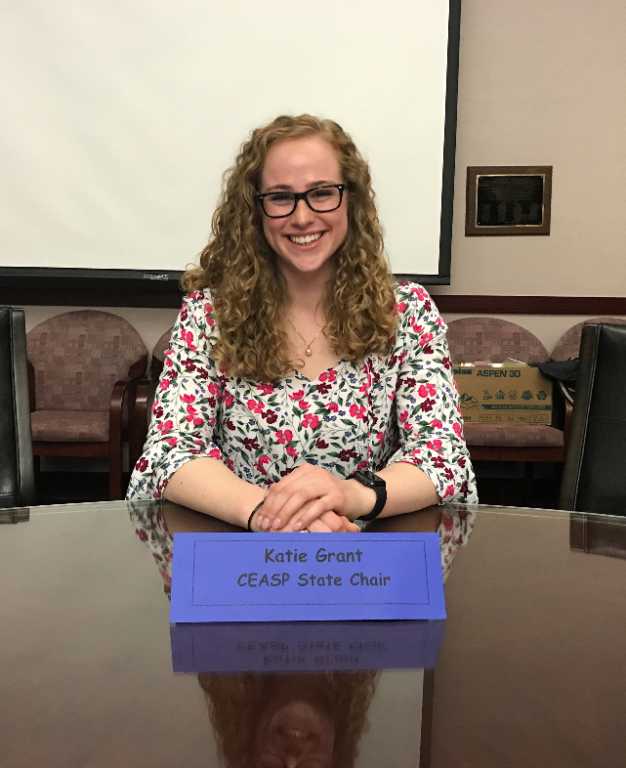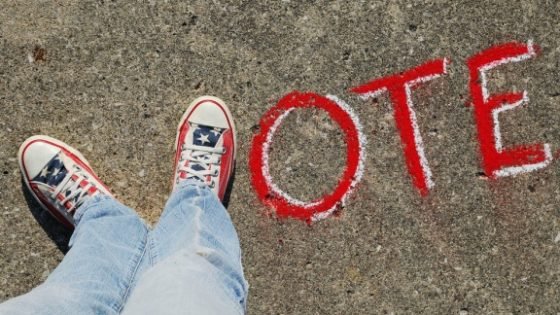Kathrine Grant, an aspiring educator completing a Master’s degree at the University of Connecticut, understands the power of voting to impact her community. Grant chose to stay registered in her hometown rather than changing her voter registration to her campus address, because she wanted to have a voice in the education-related issues being litigated in her own school district. For Grant, having a voice in her community’s decision-making is worth the extra time and energy required.
Whenever there is a local or national race in Grant’s community, she wakes up early in the morning, drives home, votes at 6:15am, and returns to campus just in time for class. Despite this effort, Grant understands deeply the importance of exercising her right to vote, not only as a citizen, but also as a future educator.

“I think voting is one of the many responsibilities we have to our students and to the profession we’re going to inherit in the future. The people who are elected now are going to make changes and policy that are going to affect our lives, our classrooms, our students, our boards of education, and our future.”
College students like Grant face unique circumstances when it comes to voting. While some of the obstacles they face are common to all voting populations, these may be exacerbated by factors that are associated with studying at a college or university.
Young people are an essential voting base and can shift the outcomes of elections. While young voters have been historically out-voted by older generations, there has been progress in youth voter turnout in recent elections. In the 2018 midterm election, a study completed by CIRCLE found that in the 42 states that report youth voting data, every single state had a youth voter turnout increase since the 2014 midterm election.
This increase reflects an increased interest in politics for young people, especially in a non-presidential election year. College age students, including aspiring educators, are more often showing up to vote in not solely national and midterm elections, but also local races that directly affect communities in which these young people live.
With a little foresight, college students can easily make powerful change in their communities by visiting the voting booth. Here is a list of hurdles that students may face, and proactive resolutions to ensure that every college student that wants to cast a vote successfully does so:
Changing State Voter Registration
Students going to school out-of-state will have the option of voting in either their home state or in the state of their college or university. Students making this decision may want to consider where they feel most connected to the issues in the area, as well as where their vote will have the largest impact. Some students become deeply ingrained in the communities around their schools and hope to influence them through voting in these local elections, while others may feel more strongly tied to their community back home. When considering where a vote will have the most impact, looking at which state or municipality is more likely to be a close race can be helpful. Once a student decides which state they’d like to vote in, they can go to their state election commission for information on registration, or use an online tool like TurboVote to make the process quick and easy.
Meeting Registration Deadlines
Some states, like Rhode Island, South Carolina, and Mississippi, require voter registration to be completed up to 30 days before an election begins. For college freshmen who have never cast a vote before and are still adjusting to the first few months of college, knowing that they must register so far in advance may not even be on their radar. However, while some states have restrictive laws, forcing voters to register a month in advance, other states are very lenient about voter registration. States like Iowa, Maine, and Wyoming allow students and other voters alike to register and vote on the day of the election. North Dakota is a particularly interesting case in the context of voter registration deadlines, as the state does not even require voter registration! Students in North Dakota solely need to bring a valid ID and proof of residency to the polls to be able to cast a vote. Proactively researching the specifics of state laws that vary so widely regarding voter registration helps ensure that everyone who wants the chance to vote will have the opportunity to.
Absentee voting

Students who chose to vote in their home state while away at school will likely not have the opportunity to return home to vote in person. Absentee voting offers them the chance to remain engaged in their home communities from afar but requires being proactive in order to allow time for requested ballots to arrive and be mailed back in time to be counted. After registering, students can request absentee ballots to be sent to their campus addresses. Some states, like Connecticut, Indiana, and Missouri, have specific requirements regarding what excuses are accepted to receive an absentee ballot. Voters should check their state’s requirements to be sure they can receive a ballot by mail. Additionally, for students studying abroad, receiving a ballot by mail can be difficult. If a ballot is requested and has not been received 30 days prior to the election, the Federal Voting Assistance Program offers an emergency back-up ballot to ensure the votes of U.S. citizens abroad are counted.
ID Laws
One of the last steps in the voting process, showing up to vote with everything you need, can be the most restrictive for college students. Voter ID laws vary widely from state to state. States like Maryland, California, and Minnesota require no documents to vote, while Wisconsin, Georgia, and Alabama all have requirements for acceptable forms of identification. A strict voter ID law was recently passed in North Carolina, requiring all voters to present photo identification when they vote. The out-of-state licenses many college students voting hold are only accepted if the voter registered within the past 90 days. In North Carolina, and other states with restrictive voting laws, getting a voter ID issued by the county election board is a simple solution. Make sure to check your state election website to ensure you have the proper form of identification before you head to your polling place.
Changing polling locations
College students are in a unique position when it concerns frequently moving. It is very common for students to move on a yearly basis, such as transitioning from a dorm to a new apartment, or moving to a different part of town in the beginning of a school year. When these changes occur, students may not be originally be fully aware that their polling location may have changed since the last time they voted. Even when a student moves only a few blocks away, that does not necessarily mean they will continue to vote at the same site. Luckily, there are many websites available for students to access information about where they can vote. There are comprehensive databases where students can enter their new address to confirm their polling location, ensuring that students know exactly where to go even after moving into a new apartment, dorm, or house. It is almost effortless for students to proactively stay educated about where they should vote, thanks to the many resources available to them.
Long voting lines? Early vote!
When students arrive at the polls, excited and prepared to make their voices heard, they may unfortunately be subject to a long voter wait time. On certain college campuses, there have been instances where students must wait for hours to finally access a ballot. At The University of Texas at Austin, students voting in the 2018 midterm election reported waiting over an hour to vote, with some of them skipping classes to persevere and cast their vote. At Arizona State University, student voters demonstrated dedication as they waited over two hours to finally vote. While some students can alter their schedule to make time to vote, others have obligations they cannot ignore, that could prevent them from voting altogether. One way students can overcome the issue of long voter wait times is by early voting. Many states offer great opportunities to vote a few days to a few weeks prior to the election. Certain states, like Vermont and South Dakota, offer very generous early voting opportunities, each allowing their state’s voters to cast a ballot 45 days prior to the election. Many other states also offer long windows of early voting. When the opportunity presents itself, early voting can be a convenient and time saving solution to standing in a long line on election day.
For more information regarding voter registration, whether it concerns college students or anyone else, reference When We All Vote, a new non-partisan non-for-profit organization that encourages voter registration for eligible Americans. In addition to their general information, the website offers resources to educators that provides information and ideas on how to expand voter registration efforts in schools and classrooms.


